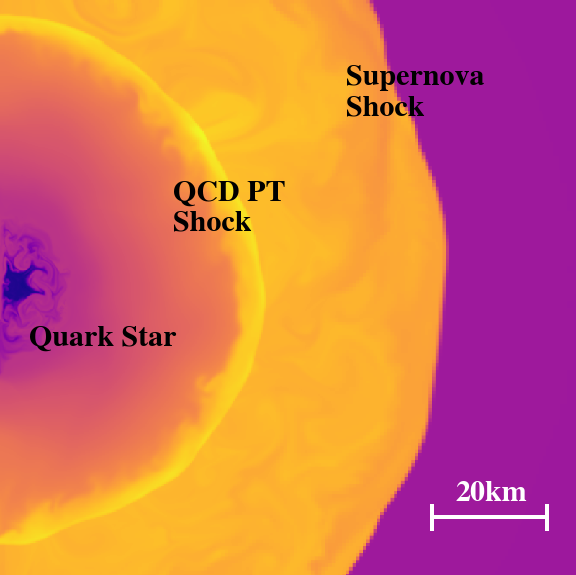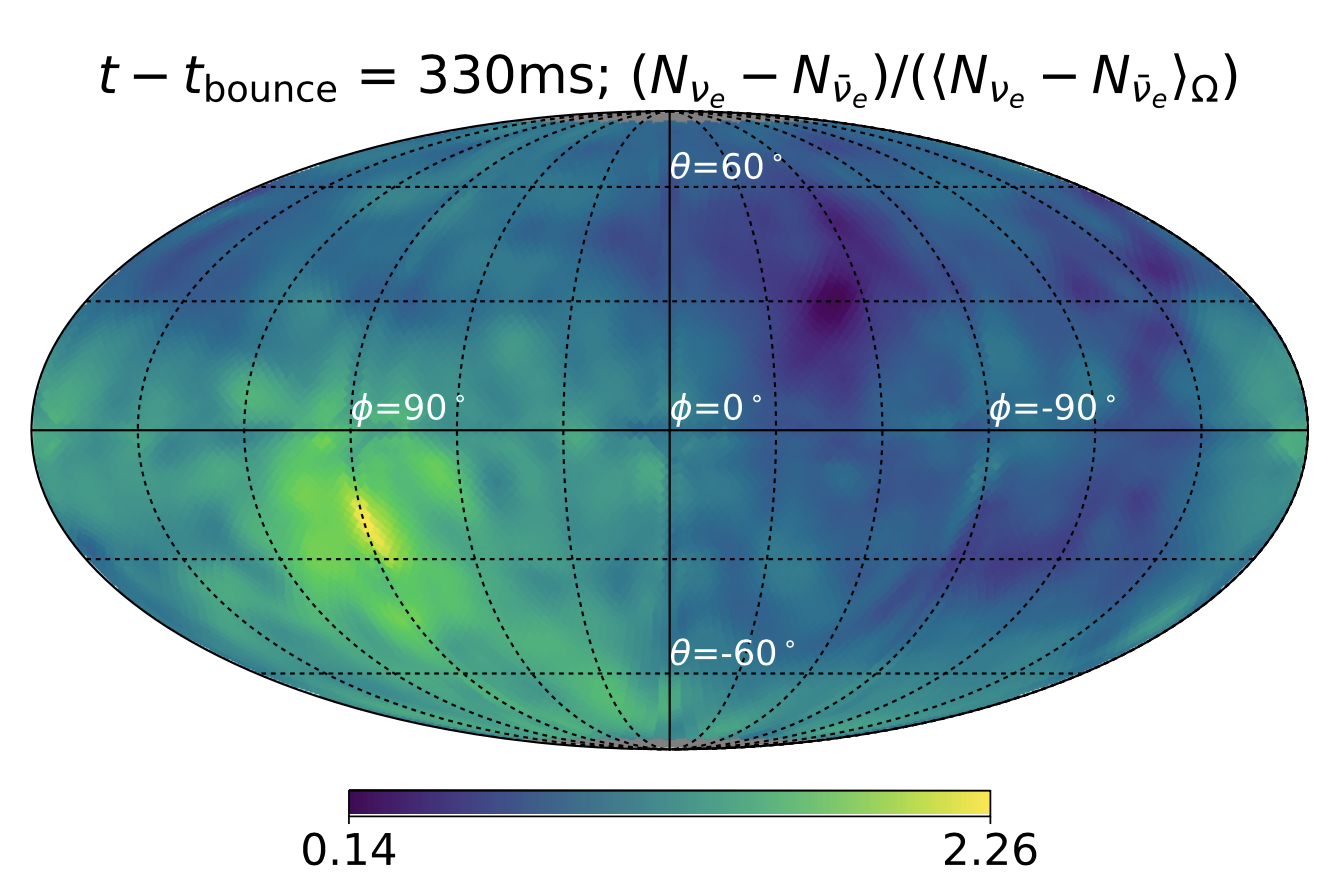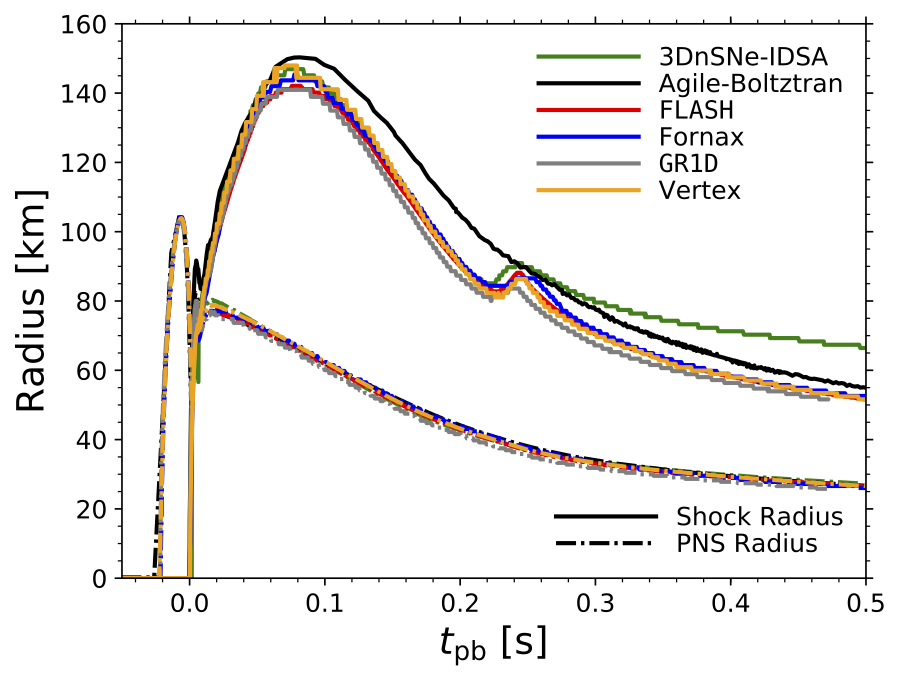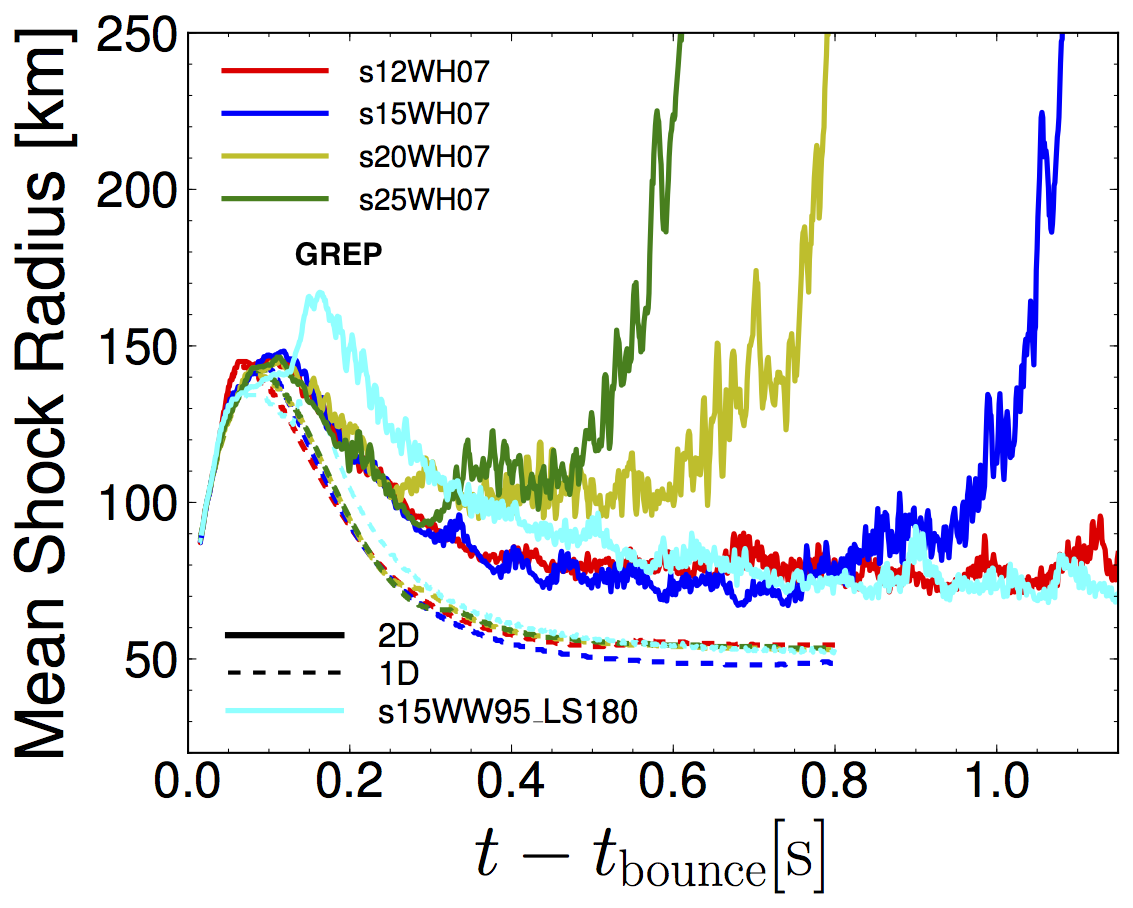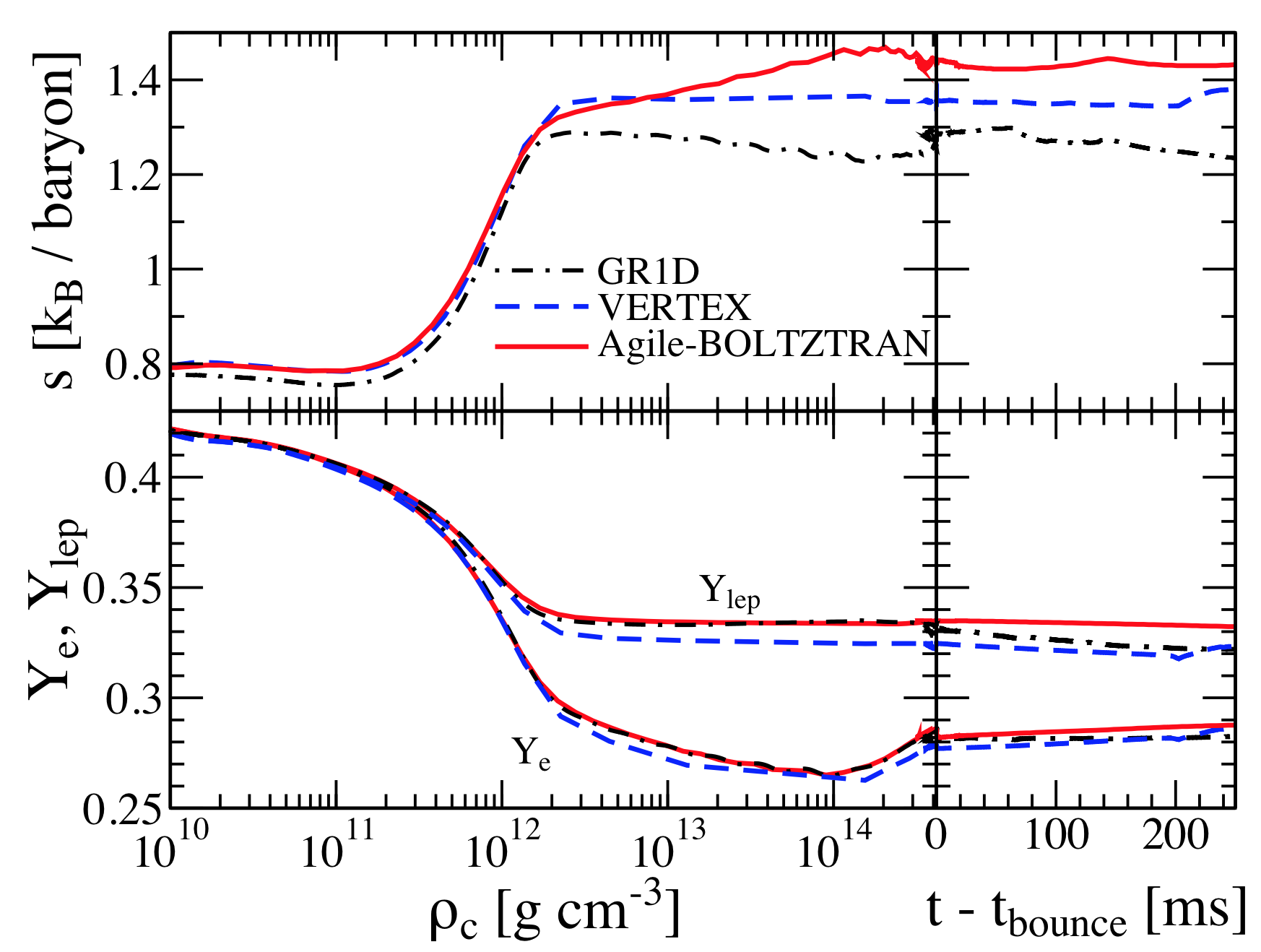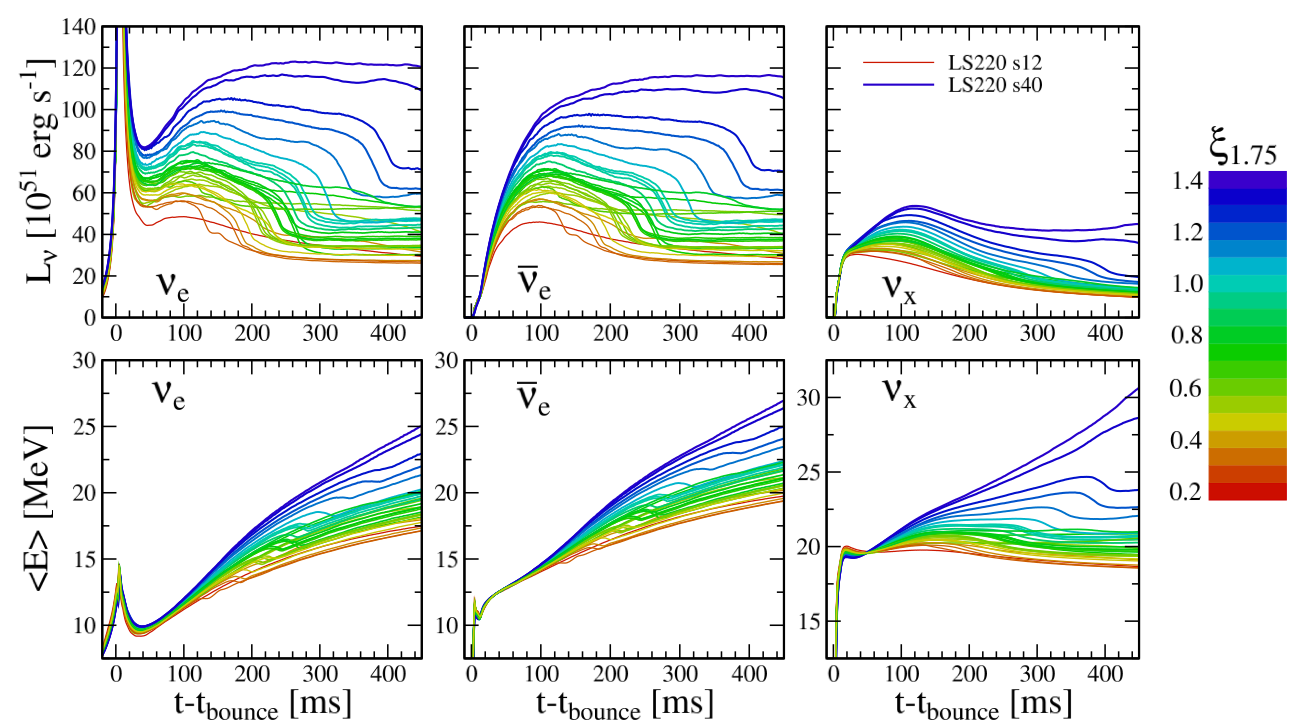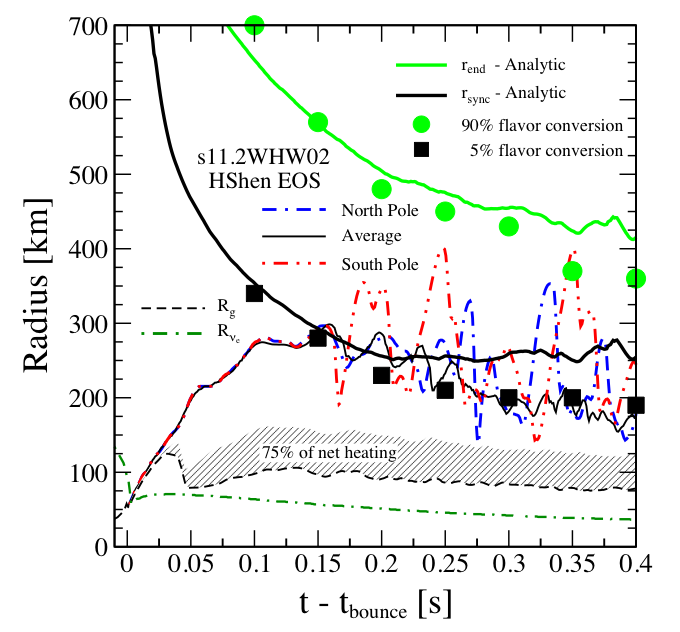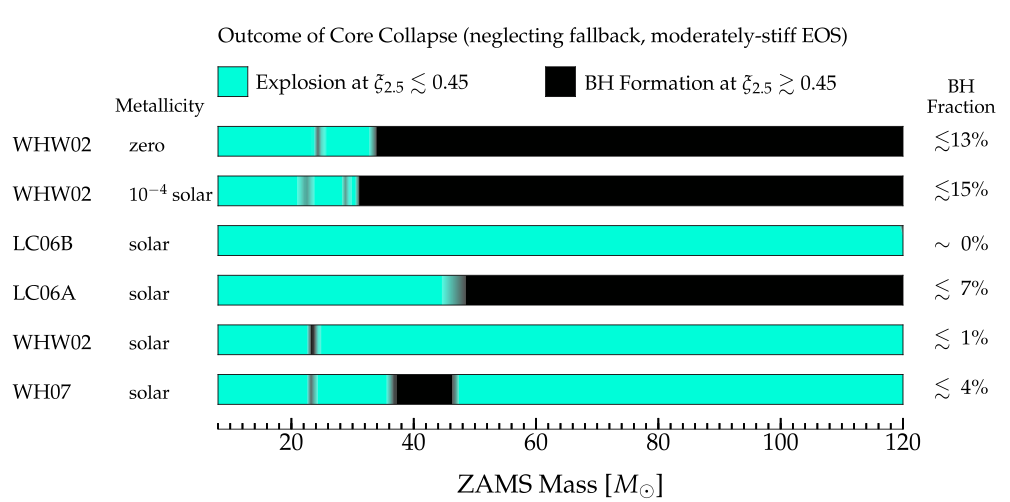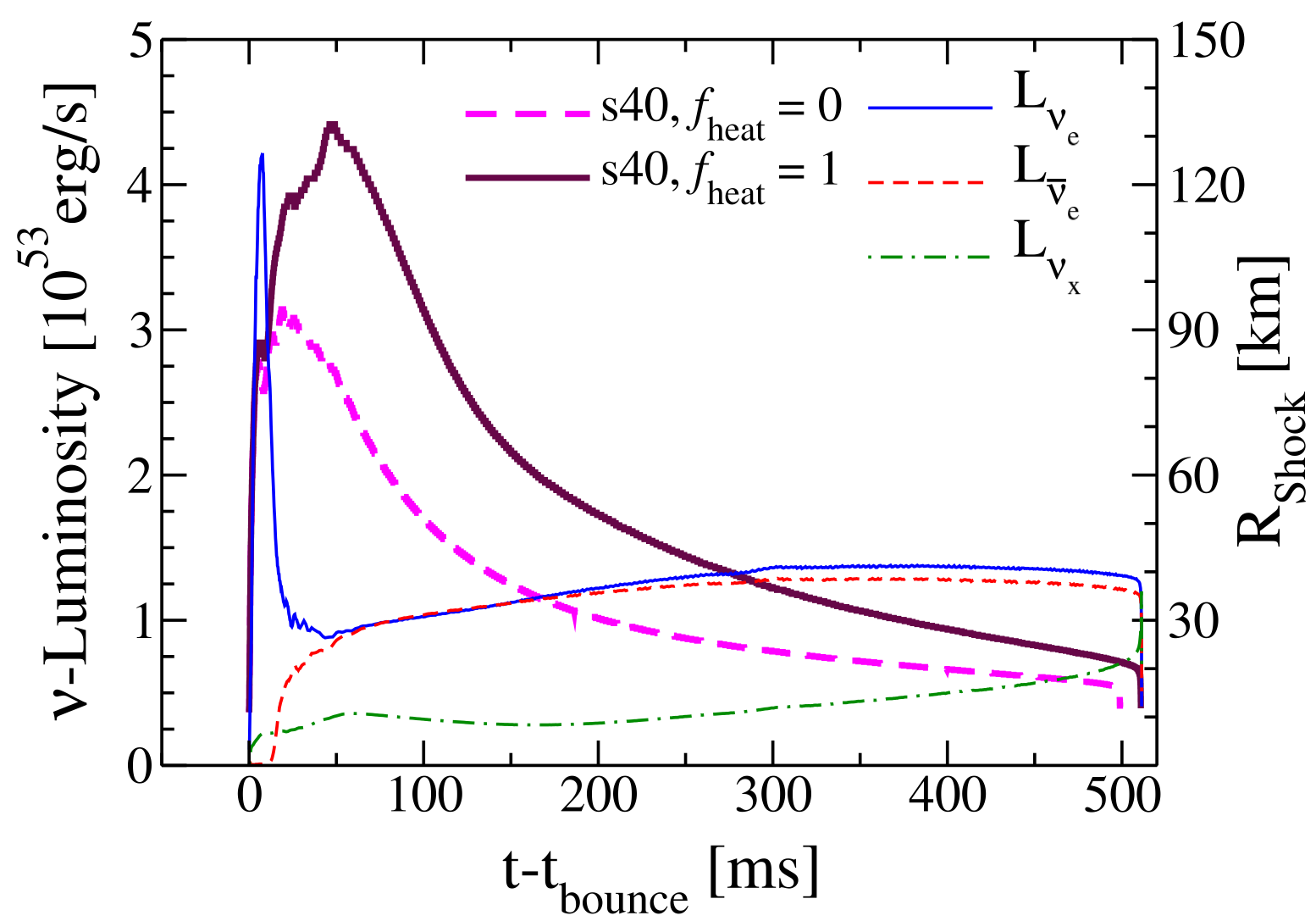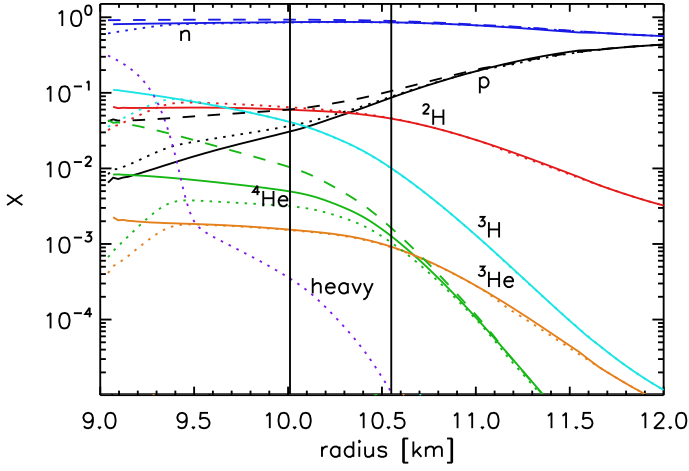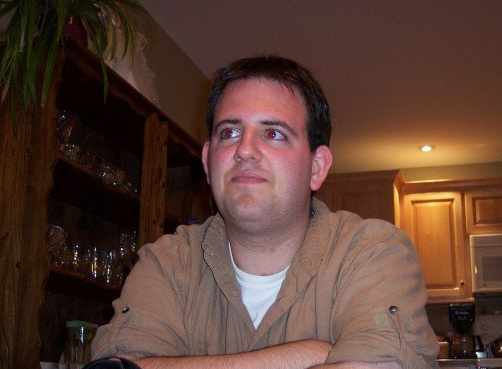
|
|
||
Open-source ToolsNuLibGR1D EOS Tables EOS Maker EOS Driver |
I am a Universitetslektor (Associate Professor) in the Astronomy Department at Stockholm University. I am mainly interested in the dynamics of compact objects via their creation in supernovae and their connection to the detailed microphysics. I am also particularly interesting the associated neutrino signal and what its measurement can tell us about the underlying microphysics. I graduated with my Ph.D. from Caltech in the TAPIR group. If you are interested, here is my thesis. I obtained my bachelor from the University of Prince Edward Island (UPEI) in 2007 in Science (Physics, Honours, Co-op). I was a postdoctoral fellow at the Canadian Institute of Astrophysics from 2012-2014 and a Hubble Fellow in the Physics Department at North Carolina State University from 2014-2017. For all the details, have a look below and/or at my CV. Here is my author query at arXiv, and my article library at Nasa ADS. |
||
|
|||
Black Hole Supernovae, their Equation of State Dependence and Ejecta Composition, O. Eggenberger Andersen, E. O'Connor, H. Andresen, A. da Silva Schneider, S. M. Couch, ApJ 980 53 2025 ApJ link, arXiv link |
|||
|
|||
Gravitational-Wave Signature of a First-Order Quantum Chromodynamics Phase Transition in Core-Collapse Supernovae, Zha, S., E. O'Connor, M.-C. Chu, L.-M. Lin, S.M. Couch, PRL 125 051102 2020 PRL link, arXiv link |
|||
|
|||
Exploring Fundamentally Three-dimensional Phenomena in High-fidelity Simulations of Core-collapse Supernovae, E. O'Connor, S. Couch, ApJ 865 81 (2018) ApJ link, arXiv link |
|||
|
|||
Global Comparison of Core-Collapse Supernova Simulations in Spherical Symmetry, E. O'Connor, R. Bollig, A. Burrows, S. Couch, T. Fischer, H.-T. Janka, K. Kotake, E. J. Lentz, M. Liebendörfer, O. E. B. Messer, A. Mezzacappa, T. Takiwaki, D. Vartanyan, Journal of Physics G: Focus issue on Core-Collapse Supernovae, JPG link, arXiv link |
|||
|
|||
Two Dimensional Core-Collapse Supernova Explosions Aided by General Relativity with Multidimensional Neutrino Transport, E. O'Connor, S. Couch, ApJ 85463 2018 ApJ link, arXiv link |
|||
|
|||
An Open-Source Neutrino Radiation Hydrodynamics Code for Core-Collapse Supernovae, E. O'Connor, ApJS 219 24 2015, ApJS link arXiv link |
|||
|
|||
The Progenitor Dependence of the Preexplosion Neutrino Emission in Core-Collapse Supernovae, E. O'Connor and C.D. Ott ApJ 762 126 ApJ link, arXiv link |
|||
|
|||
The Role of Collective Neutrino Flavor Oscillations in Core-Collapse Supernova Shock Revival, B. Dasgupta, E. O'Connor, C. D. Ott PRD 85 065008 (2012). PRD link, arXiv link |
|||
|
|||
Black Hole Formation in Failing Core-Collapse Supernovae, E. O'Connor and C. D. Ott, Astrophys. J. 730 70 (2011) ApJ link, arXiv link |
|||
|
|||
A New Open-Source Code for Spherically-Symmetric Stellar Collapse to Neutron Stars and Black Holes, E. O'Connor and C. D. Ott, Class. Quan. Grav. 27, 114103 (2010). CQG link, arXiv link |
|||
|
|||
Influence of light nuclei on neutrino-driven supernova outflows, A. Arcones, G. Martinez-Pinedo, E. O'Connor, A. Schwenk, H.-Th. Janka, C. J. Horowitz, and K. Langanke, Phys. Rev. C 78, 015806 (2008). PRC link, arXiv link |
|||
|
|||
Neutrino Breakup of A=3 Nuclei in Supernovae, E. O'Connor, D Gazit, C. J. Horowitz, A. Schwenk, and N. Barnea, Phys. Rev. C 75, 055803 (2007). PRC link, arXiv link |
|||
|
|||
|
|||
Phase-transition-induced Collapse of Proto-compact Stars and Its Implication for Supernova Explosions, Huang, X.-R., Zha, S., Chu, M.-. chung ., O'Connor, E.P., and Chen, L.-W., ApJ 979 151 2025 ApJ link arXiv link Neutrino Heating in 1D, 2D, and 3D core-collapse supernovae: characterizing the explosion of high-compactness stars, Boccioli, L., Vartanyan, D., O'Connor, E.P., and Kasen, D., arXiv arXiv:2501.06784 2025 arXiv link Quantifying the impact of the Si/O interface in CCSN explosions using the Force Explosion Condition, Boccioli, L., Gogilashvili, M., Murphy, J., and O'Connor, E.P., MNRAS.tmp 2025 MNRAS.tmp link arXiv link Black Hole Supernovae, their Equation of State Dependence and Ejecta Composition, Eggenberger Andersen, O., O'Connor, E., Andresen, H., da Silva Schneider, A., and Couch, S.M., arXiv arXiv:2411.11969 2024 arXiv link Data-driven core collapse supernova multilateration with first neutrino events, Azfar, F., Tseng, J., Colomer Molla, M., Scholberg, K., Habig, A., BenZvi, S., Kara, M., Kneller, J., Migenda, J., Milisavljevic, D., and O'Connor, E., arXiv arXiv:2410.11984 2024 arXiv link Gray two-moment neutrino transport: Comprehensive tests and improvements for supernova simulations, Andresen, H., O'Connor, E.P., Andersen, O.E., and Couch, S.M., A&A 687 A55 2024 A&A link arXiv link Unveiling the nature of gravitational-wave emission in core-collapse supernovae with perturbative analysis, Zha, S., Eggenberger Andersen, O., and O'Connor, E.P., PhRvD 109 083023 2024 PhRvD link arXiv link Detectability of neutrino-signal fluctuations induced by the hadron-quark phase transition in failing core-collapse supernovae, Lin, Z., Zha, S., O'Connor, E.P., and Steiner, A.W., PhRvD 109 023005 2024 PhRvD link arXiv link The force explosion condition is consistent with spherically symmetric CCSN explosions, Gogilashvili, M., Murphy, J.W., and O'Connor, E.P., MNRAS 524 4109 2023 MNRAS link arXiv link Inferring Type II-P Supernova Progenitor Masses from Plateau Luminosities, Barker, B.L., O'Connor, E.P., and Couch, S.M., ApJL 944 L2 2023 ApJL link arXiv link A Parameterized Neutrino Emission Model to Study Mass Ejection in Failed Core-collapse Supernovae, da Silva Schneider, A. and O'Connor, E., ApJ 942 16 2023 ApJ link arXiv link Impact of rotation on the multimessenger signatures of a hadron-quark phase transition in core-collapse supernovae, Zha, S. and O'Connor, E., PhRvD 106 123037 2022 PhRvD link arXiv link Comparison of Electron Capture Rates in the N = 50 Region using 1D Simulations of Core-collapse Supernovae, Johnston, Z., Wasik, S., Titus, R., Warren, M.L., O'Connor, E.P., Zegers, R., and Couch, S.M., ApJ 939 15 2022 ApJ link arXiv link Horizons: nuclear astrophysics in the 2020s and beyond, Schatz, H. et al., JPhG 49 110502 2022 JPhG link arXiv link Neutrino driven explosions aided by axion cooling in multidimensional simulations of core-collapse supernovae, Betranhandy, A. and O'Connor, E., PhRvD 106 063019 2022 PhRvD link arXiv link Connecting the Light Curves of Type IIP Supernovae to the Properties of Their Progenitors, Barker, B.L., Harris, C.E., Warren, M.L., O'Connor, E.P., and Couch, S.M., ApJ 934 67 2022 ApJ link arXiv link Hydrodynamic simulations of electron-capture supernovae: progenitor and dimension dependence, Zha, S., O'Connor, E.P., Couch, S.M., Leung, S.-C., and Nomoto, K., MNRAS 513 1317 2022 MNRAS link arXiv link SNEWPY: A Data Pipeline from Supernova Simulations to Neutrino Signals, Baxter, A.L., Benzvi, S., Jaimes, J.C., Coleiro, A., Molla, M.C., Dornic, D., Goldhagen, T., Graf, A., Griswold, S., Habig, A., Hill, R., Horiuchi, S., Kneller, J.P., Lang, R.F., Lincetto, M., Migenda, J., Nakamura, K., O'Connor, E., Renshaw, A., Scholberg, K., Tunnell, C., Uberoi, N., Worlikar, A., and The Snews Collaboration, ApJ 925 107 2022 ApJ link JOSS link arXiv link Effect of the Nuclear Equation of State on Relativistic Turbulence-induced Core-collapse Supernovae, Boccioli, L., Mathews, G.J., Suh, I.-S., and O'Connor, E.P., ApJ 926 147 2022 ApJ link arXiv link Neutrino Echos following Black Hole Formation in Core-collapse Supernovae, Gullin, S., O'Connor, E.P., Wang, J.-S., and Tseng, J., ApJ 926 212 2022 ApJ link arXiv link Equation-of-state Dependence of Gravitational Waves in Core-collapse Supernovae, Eggenberger Andersen, O., Zha, S., da Silva Schneider, A., Betranhandy, A., Couch, S.M., and O'Connor, E.P., ApJ 923 201 2021 ApJ link arXiv link Nonradial neutrino emission upon black hole formation in core collapse supernovae, Wang, J.-S., Tseng, J., Gullin, S., and O'Connor, E.P., PhRvD 104 104030 2021 PhRvD link arXiv link Calibration of the Advanced Spectral Leakage scheme for neutron star merger simulations, and extension to smoothed-particle hydrodynamics, Gizzi, D., Lundman, C., O'Connor, E., Rosswog, S., and Perego, A., MNRAS 505 2575 2021 MNRAS link arXiv link Supernova Model Discrimination with Hyper-Kamiokande, Abe, K. et al. ApJ 916 15 2021 ApJ link arXiv link Determining the Structure of Rotating Massive Stellar Cores with Gravitational Waves, Pajkos, M.A., Warren, M.L., Couch, S.M., O'Connor, E.P., and Pan, K.-C., ApJ 914 80 2021 ApJ link arXiv link General Relativistic Neutrino-driven Turbulence in One-dimensional Core-collapse Supernovae, Boccioli, L., Mathews, G.J., and O'Connor, E.P., ApJ 912 29 2021 ApJ link arXiv link Progenitor Dependence of Hadron-quark Phase Transition in Failing Core-collapse Supernovae, Zha, S., O'Connor, E.P., and da Silva Schneider, A., ApJ 911 74 2021 ApJ link arXiv link SNEWS 2.0: a next-generation supernova early warning system for multi-messenger astronomy, Al Kharusi, S. et al. NJPh 23 031201 2021 NJPh link arXiv link Measuring the distance and mass of galactic core-collapse supernovae using neutrinos, Segerlund, M., O'Sullivan, E., and O'Connor, E., arXiv arXiv:2101.10624 2021 arXiv link Impact of neutrino pair-production rates in core-collapse supernovae, Betranhandy, A. and O'Connor, E., PhRvD 102 123015 2020 PhRvD link arXiv link Constraining Properties of the Next Nearby Core-collapse Supernova with Multimessenger Signals, Warren, M.L., Couch, S.M., O'Connor, E.P., and Morozova, V., ApJ 898 139 2020 ApJ link arXiv link Gravitational-wave Signature of a First-order Quantum Chromodynamics Phase Transition in Core-Collapse Supernovae, Zha, S., O'Connor, E., Chu, M.-C., Lin, L.-M., Couch, S.M., PRL 125 051102 2020 PRL link arXiv link Constraining properties of the next nearby core-collapse supernova with multi-messenger signals, Warren, M.L., Couch, S.M., O'Connor, E., Morozona, V. ApJ 898 139 2020 ApJ link arXiv link Equation of State and Progenitor Dependence of Stellar-mass Black Hole Formation, Schneider, A., O'Connor, E., Granqvist, E., Betranhandy, A. Couch, S.M., ApJ 894 4 2020 ApJ Link arXiv link Simulating Turbulence-aided Neutrino-driven Core-collapse Supernova Explosions in One Dimension, Couch, S.M., O'Connor, E., Warren, M. L. ApJ 890 127 2020 ApJ link arXiv link Multimessenger asteroseismology of core-collapse supernovae, Westernacher-Schneider, J.R., O'Connor, E., O'Sullivan, E., Tamborra, I., Wu, M.-R., Couch, S.M., Malmenbeck, F., PRD 100 123009 2019 PRD link arXiv link A multidimensional implementation of the Advanced Spectral neutrino Leakage scheme, Gizzi, D., O'Connor, E., Rosswog, S., Perego, A., Cabezon, R.M., Nativi, L., MNRAS 490 4211 2019 MNRAS link arXiv link Equation of state effects in the core collapse of a 20 solar mass star, Schneider, A., Roberts, L. Ott, C., O'Connor, E., PRC 100 055802 2019 PRC link arXiv link Features of Accretion-phase Gravitational-wave Emission from Two-dimensional Rotating Core-collapse Supernovae, Pajkos, M.A., Couch, S.M., Pan, K.-C., O'Connor, E., ApJ 878 13, 2019 ApJ link arXiv link Evolution of the Progenitors of SNe 1993J and 2011dh Revealed through Late-time Radio and X-Ray Studies, Kundu, E., Lundqvist, P., Sorokina, E., Perez-Torres, M. A., Blinnikov, S., O'Connor, E., Ergon, M., Chandra, P., Das, B., ApJ 875 17 2019 ApJ link arXiv link The Impact of Different Neutrino Transport Methods on Multidimensional Core-collapse Supernova Simulations, Pan, K.C., Mattes, C. O'Connor, E., Couch, S.M., Perego, A., Arcones, A. Journal of Physics G: Focus issue on Core-Collapse Supernovae 46 014001 2019 JPG link arXiv link Elastic Scattering in General Relativistic Ray Tracing for Neutrinos Deaton, M.B., O'Connor, E., Zhu, Y.L., Bohn, A., Jesse, J., Foucart, F., Duez, M.D., McLaughlin, G.C., PRD 98 103014 2018 PRD link, arXiv link Global Comparison of Core-Collapse Supernova Simulations in Spherical Symmetry, O'Connor, E., Bollig, R., Burrows, A., Couch, S., Fischer, T., Janka, H.T., Kotake, K., Lentz E.J., Liebendörfer, M., Messer, O.E.B., Mezzacappa, A., Takiwaki, T., Vartanyan, D., Journal of Physics G: Focus issue on Core-Collapse Supernovae 45 104001 2018 JPG link arXiv link Exploring Fundamentally Three-dimensional Phenomena in High-fidelity Simulations of Core-collapse Supernovae, O'Connor, E., Couch, S. ApJ 865 81 2018 ApJ link arXiv link Black hole-neutron star mergers using a survey of finite-temperature equations of state, Brege, W., Duez, M. D., Foucart, F., Deaton, M. B., Caro, J., Hemberger, D. A., Kidder, L. E., O'Connor, E. Pfeiffer, H. P., Scheel, M. A., PRD 98 063009 2018 PRD link arXiv link Two Dimensional Core-Collapse Supernova Explosions Aided by General Relativity with Multidimensional Neutrino Transport, O'Connor, E., Couch, S. ApJ 854 63 2018 ApJ link arXiv link Equation of state effects on gravitational waves from rotating core collapse, Richers, S., Ott, C. D., Abdikamalov, E.,O'Connor, E., Sullivan, C., PRD 95 063019 2017 PRD link arXiv link Neutrino-nucleon scattering in supernova matter from the virial expansion, Horowitz, C. J., Caballero, O. L., Lin, Z., O'Connor, E., Schwenk, A., PRC 95 025801 2017 PRC link arXiv link Impact of an improved neutrino energy estimate on outflows in neutron star merger simulations, Foucart, F., O'Connor, E., Roberts, L., Kidder, L. E., Pfeiffer, H. P., Scheel, M. A., PRD 94 123016 2016 PRD link arXiv link Nuclear pasta and supernova neutrinos at late times, Horowitz, C. J., Berry, D. K., Caplan, M. E., Fischer, T., Lin, Z., Newton, W. G., O'Connor, E., Roberts, L. F., submitted to PRL arXiv link General-Relativistic Three-Dimensional Multi-group Neutrino Radiation-Hydrodynamics Simulations of Core-Collapse Supernovae, Roberts, L. F., Ott, C. D., Haas, R., O'Connor, E., Diener, P., Schnetter, E., ApJ link arXiv link Unequal mass binary neutron star mergers and multimessenger signals, Lehner, L., Liebling, S. L., Palenzuela, C., Caballero, O. L., O'Connor, E, Anderson, M., Neilsen, D., CQG 33 184002 2016 CQG link arXiv link Ankowski et al., White paper on Supernova Physics at DUNE arXiv link Low mass binary neutron star mergers: gravitational waves and neutrino emission, Foucart, F., Haas, R., Duez, M. D., O'Connor, E., Ott, C. D., Roberts, L., Kidder, L. E., Lippuner, J., Pfeiffer, H. P., Scheel, M. A., PRD 93 044019 2016 PRD link arXiv link The Sensitivity of Core-Collapse Supernovae to Nuclear Electron Capture, Sullivan, C., O'Connor, E., Zegers, R. G. T., Grubb, T., Austin, S. M., ApJ 816 44 2016 ApJ link arXiv link Monte Carlo Neutrino Transport Through Remnant Disks from Neutron Star Mergers, Richers, S., Kasen, D., O'Connor, E., Fernandez, R., Ott, C.D., ApJ 813 38 2015 ApJ link arXiv link Effects of the microphysical Equation of State in the mergers of magnetized Neutron Stars With Neutrino Cooling, Palenzuela, C., Liebling, S. L., Neilsen, D., Lehner, L., Caballero, O. L., O'Connor, E. Anderson, M., PRD 92 044045 2015 PRD link arXiv link An Open-Source Neutrino Radiation Hydrodynamics Code for Core-Collapse Supernovae, O'Connor, E. ApJS 219 24 2015 ApJS link arXiv link Post-merger evolution of a neutron star-black hole binary with neutrino transport, Foucart, F., O'Connor, E, Roberts, L., Duez, M.D., Haas, R., Kidder, L.E., Ott, C.D. Pfeiffer, H.P., Scheel, M.A., Szilagyi, B., PRD 91 124021 2015 PRD Link arXiv link Magnetized neutron stars with realistic equations of state and neutrino cooling, Neilsen, D., Liebling, S.L., Anderson, M., Lehner, L., O'Connor, E. Palenzuela, C., PRD 89 104029 2014 PRD link arXiv link Neutron star-black hole mergers with a nuclear equation of state and neutrino cooling: Dependence in the binary parameters, Foucart, F., Deaton, M. B., Duez, M. D., O'Connor, E., Ott, C. D., Haas, R., Kidder, L. E., Pfeiffer, H. P., Scheel, M. A., Szilagyi, B. PRD 90 024026 2014 PRD Link arXiv link High-Resolution Three-Dimensional Simulations of Core-Collapse Supernovae in Multiple Progenitors, Couch, S. M., O'Connor, E., ApJ 785 123 2014 ApJ link arXiv link The Influence of Thermal Pressure on Hypermassive Neutron Star Merger Remnants, Kaplan, J. D., Ott, C. D., O'Connor, E., Kiuchi, K., Roberts, L., Duez, M. ApJ 790 19 2014 ApJ Link arXiv link Black Hole-Neutron Star Mergers with a Hot Nuclear Equation of State: Outflow and Neutrino-Cooled Disk for a Low-Mass, High-Spin Case, Deaton, M. B., Duez, M. D., Foucart, F., O'Connor, E., Ott, C. D., Kidder, L. E., Muhlberger, C. D., Scheel, M. A., Szilagyi, B. ApJ 776 47 (2013) ApJ link arXiv link General-Relativistic Simulations of Three-Dimensional Core-Collapse Supernovae, Ott, C.D., Abdikamalov, E., Moesta, P., Haas, R., Drasco, S., O'Connor, E., Reisswig, C., Meakin, C., Schnetter, E. ApJ 768 115 (2013), ApJ link arXiv link The Progenitor Dependence of the Preexplosion Neutrino Emission in Core-Collapse Supernovae, O'Connor, E. and Ott, C.D. ApJ 762 126 (2013), ApJ link arXiv link Charged current neutrino interactions in core-collapse supernovae in a virial expansion, Horowitz, C.J., Shen, G., O'Connor, E., C.D. Ott PRC 86 065806 (2012) PRC link arXiv link Correlated Gravitational Wave and Neutrino Signals from General-Relativistic Rapidly Rotating Iron Core Collapse, Ott, C.D., Abdikamalov, E., O'Connor, E., Reisswig, C., Haas, R., Kalmus, P., Drasco, S., Burrows, A., Schnetter, E. PRD 86 024026 (2012), arXiv link PRD link A New Monte Carlo Method for Time-Dependent Neutrino Radiation Transport, Abdikamalov, E., Burrows, A., Ott, C.D., Loeffler, F., O'Connor, E., Dolence, J., Schnetter, E. ApJ 755 111 (2012), arXiv link ApJ link The Arduous Journey to Black-Hole Formation in Potential Gamma-Ray Burst Progenitors, Dessart, L., O'Connor, E., Ott, C.D. ApJ 754 76 (2012), ApJ link arXiv link The Role of Collective Neutrino Flavor Oscillations in Core-Collapse Supernova Shock Revival, Dasgupta, B., O'Connor, E., Ott, C.D. PRD 85 065008 (2012). PRD link, arXiv link A Second Relativistic Mean Field and Virial Equation of State for Astrophysical Simulations, Shen, G., Horowitz, C.J., O'Connor, E., PRC 83 065808 (2011). PRC link, arXiv link Black Hole Formation in Failing Core-Collapse Supernovae, O'Connor, E. and Ott, C.D. ApJ 730 70 (2011). ApJ link, arXiv link Dynamics and Gravitational Wave Signature of Collapsar Formation, Ott, C.D., Reisswig, C., Schnetter, E., O'Connor, E., Sperhake, U., Loeffler, F., Diener, P., Abdikamalov, E., Hawke, I. and Burrows, A. PRL 106 161103 2011, PRL link, arXiv link A New Open-Source Code for Spherically-Symmetric Stellar Collapse to Neutron Stars and Black Holes, O'Connor, E. and Ott, C.D., Class. Quan. Grav. 27, 114103 (2010). CQG link, arXiv link Influence of light nuclei on neutrino-driven supernova outflows, Arcones, A., Martinez-Pinedo, G., O'Connor, E., Schwenk, A., Janka, H.Th., Horowitz, C.J., and Langanke, K., Phys. Rev. C 78, 015806 (2008). PRC link, arXiv link Neutrino Breakup of A=3 Nuclei in Supernovae, O'Connor, E., Gazit, D., Horowitz, C.J., Schwenk, A., and Barnea, N., Phys. Rev. C 75, 055803 (2007). PRC link, arXiv link Measurement of the 40Ca(α,γ)44Ti reaction relevant for supernova nucleosynthesis, Vockenhuber, C., Ouellet, C. O., The, L.-S., Buchmann, L., Caggiano, J., Chen, A. A., Crawford, H., D'Auria, J. M., Davids, B., Fogarty, L., Frekers, D., Hussein, A., Hutcheon, D. A., Kutschera, W., Laird, A. M., Lewis, R., O'Connor, E., Ottewell, D., Paul, M., Pavan, M. M., Pearson, J., Ruiz, C., Ruprecht, G., Trinczek, M., Wales, B., Wallner, A., Phys. Rev. C 76, 035801 (2007). PRC link Charge-state distributions after radiative capture of helium nuclei by a carbon beam, Zylberberg, J., Hutcheon, D., Buchmann, L., Caggiano, J., Hannes, W. R., Hussein, A., O'Connor, E., Ottewell, D., Pearson, J., Ruiz, C., Ruprecht, G., Trinczek, M. and Vockenhuber, C. , NIM-B 254, 17 (2007). Science Direct link Radio emission models of colliding-wind binary systems. Inclusion of IC cooling., Pittard, J. M., Dougherty, S. M., Coker, R. F., O'Connor, E., Bolingbroke, N. J., Astron. and Astrophys. 446, 1001 (2006). Astronomy and Astrophysics link, arXiv link |
|||
January, 2025 |
|||

